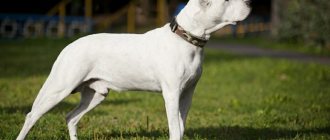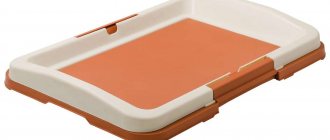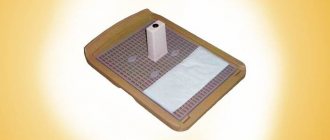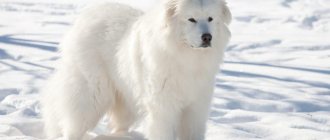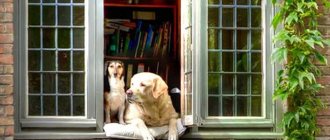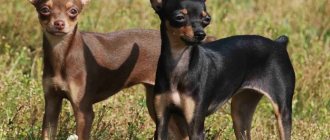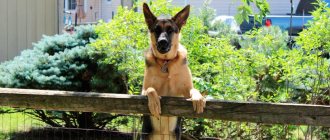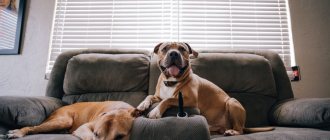Hunting dogs are a separate type of domestic animal with its own habits, habits, and character traits. They do not rush to protect their owner in case of danger, they do not strive to protect a house or apartment, and street smells during a walk interest them much more than playing with their owner and relatives.
But when hunting, these dogs are irreplaceable - they are ready to sit in ambush for hours or chase game non-stop. Their impeccable sense of smell will allow the owner not to miss the animal and return from the hunt with prey every time.
You need to approach the choice of a dog responsibly, focusing on your own needs and the characteristics of the breed. In order not to be mistaken, we have compiled the TOP hunting dogs based on the advice of dog handlers and experienced hunters.
Spaniels
There are several breeds united by one name - spaniel. Spaniels are still used for the true calling and purpose of the breed - hunting. English and Russian spaniels are unsurpassed hunters who have retained the best qualities of the species. But in the hunting breed there are animals - exclusively decorative ones - for which hunting is a distant past. These breeds include the King Charles Spaniel or Cavalier King Charles Spaniel, and the American Cocker Spaniel. Regardless of the purpose of the pet, spaniels are united by kindness and dependence on the owner. Spaniels are characterized by a cheerful disposition and an easy-going character; the peculiarity of the breed is the absence of aggression. Spaniels are easy to learn, get along easily with other animals, and love children.
Affenpinscher
The monkey pinscher (this is how the name of the breed is translated from German) is a funny decorative creature whose face really looks like the grimace of a primate. The coat of the Black Pinschers is very coarse, short on the body and long on the muzzle, which gives it a funny “disheveled” appearance. Despite its modest size, this baby carries himself with the dignity of a large and strong dog.
It is recommended to periodically pluck the fur on the sides of the animal, and trim the fur on the face with scissors. He is very jealous of his owner, trying to prevent anyone from getting into a relationship with him. Does not get along with cats and other small pets.
Basset Hound
Another dog breed with large ears is the Basset Hound. The Basset is a dog with a large body on short legs - a real hound. Basset hounds have an incredibly developed sense of smell; these dogs have not lost their instincts over the years of existence as domestic companions. The personality of the Basset is complex - it is not suitable for everyone; it is difficult for beginners in dog breeding to cope with raising a resistant animal. Pets are famous for their unsurpassed stubbornness; to raise such a dog you will have to spend much more time and patience than when training a service breed. Despite its funny appearance, the basset is more of a working dog and during a walk, if it smells an interesting smell, the dog will follow the scent, not paying attention to the owner’s dissatisfaction.
Havanese Bichon
These perky little furballs are full of cheerfulness and energy. Havanese Bichons are native to Cuba . In addition to their floppy ears, they also have a luxurious coat that needs grooming more often than other dog breeds. Be sure to check their ears often to remove wax and wipe the inside of their ears with a paper towel from time to time.
Beagle
Among hunting breeds there are many dogs with long ears (the length of the ear is no shorter than the middle of the muzzle). Beagle was no exception. The breed has recently become popular as a city dog due to its cartoonish appearance. Beagles are non-aggressive, friendly canines, get along well with children, and love all family members. Despite his attractive appearance and good-natured character, the dog has a hunting background. During a walk, the pet can get carried away with the prey and run away forever; a compact dog requires walking for at least 3 hours a day. Most hunting breeds are hyperactive - dachshunds, Jagd terriers, hounds.
Read more about the Beagle breed
Likes
Laikas have excellent sense of smell and endurance. They are considered the most versatile of all hunting breeds. They pursue prey quickly, silently. When a husky catches up with an animal, it notifies the hunter of its detention with a ringing bark. Helps to pursue wild boar and elk, small fur-bearing animals and birds.
Laikas are sometimes used in harnesses as sled dogs. They are calm, curious, friendly and graceful animals. Unpretentious and independent. At the same time, they need long walks in any weather.
Popular breeds: West Siberian, Russian-European and Karelian Laika, Finnish Spitz:
- The West Siberian is considered one of the best hunting assistants. She moves silently and is capable of driving out a large animal. These are fearless animals that do not retreat even in front of an elk. It is better to train such a husky to hunt a certain type of game. Then the effectiveness of innate hunting instincts will increase significantly.
- The Russian-European Laika is calm and self-possessed. She patiently tracks the animal, instantly getting on the trail. A distinctive feature of the breed is energy and mobility. The Russian-European Laika has a muscular body. It pursues prey for a long time even in rainy weather. He chases the animal through the snow for several hours without rest.
- The Karelian Laika, or bear dog, is used for hunting large animals. In addition to its main purpose, it is engaged in search. This is a reliable and hardy dog that helps in hunting wild boar, elk and bear.
- The Finnish Spitz is a type of husky. Excellent at tracking small animals and birds. This is a very smart, loyal dog. Friendly and active.
Setters
Setters are the true aristocrats of the dog world. Setters still participate in the hunt, demonstrating incredible skill and willingness to work. All representatives of the breed (English, Irish) have a soft, friendly character; they are true companions who cannot imagine life without a family. The setter requires a lot of attention because... Without communication with the owner, animals can even become seriously ill. Setters are easy to train, get along easily with other animals, and love children very much. Another advantage of the species is the wool - soft, shiny, like silk of the highest quality.
A little history
Knowledge about the types of hunting dogs was first recorded in the manuscripts of the ancient Romans. They respected their enormous patience, sense of smell and flair, admired their unexpected lightning-fast throws and victories over the game after tracking it down.
But the Romans created animals to suit their needs, the goal of Rome was to use protective qualities. The population of neighboring European countries, on the contrary, specially bred dogs, using animal hunting as their basis. Thus, ancient scientists and breeders, observing for a long time the processes of maturation from puppies to mature individuals, selected predatory catchers, drawing up their current classification and division. European dogs showed fine intelligence, speed, and mobility.
Poodle
The dog of French origin is famous for its intelligence and high intelligence. Puppies up to a year old show amazing tricks that even adult service breeds cannot perform. Poodles often perform in circuses due to their mental abilities and love of work. The poodle is not necessarily a decorative companion. This subspecies is divided into 4 types - large (up to 60 cm at the withers), small, dwarf and toy poodle (slightly more than 20 cm at the withers). The breed has a calm character, these animals love children and get along easily with other animals. Poodles' incredible coat requires little maintenance. With the exception of show dogs, dogs participating in exhibitions must be trimmed according to the appropriate grooming standards for the breed. Without a haircut, a poodle is not allowed to show, but the dog can participate in breeding.
Rottweiler
According to the standard, this breed is not completely black; there are red areas on the chest and face of the animal. The Rottweiler's build is stocky and muscular. The breed was originally bred to transport small loads, but now this dog serves as a guard. He is very jealous of his territory and is wary of strangers.
Read Top 20 smallest dogs - small breeds
The coat is very thick and short, requiring no special care. Due to their thick undercoat, they tolerate cold well. Dogs of this breed must be trained, and this should be done by professionals. An untrained Rottweiler can pose a threat even to its owners.
Saluki
One of the most ancient breeds, the Saluki originates in the Middle East. There are two types of wool depending on the region of origin - long-haired and short-haired. Salukis are timid with strangers, but affectionate with family members. Salukis become very attached to people and have a hard time with long separations. The genetic feature of the species is that they do not get along easily with other animals; the level of communication increases with the help of early socialization. They require walking for at least 3 hours a day and lots of physical activity. The hunting instinct of the graceful Saluki has been nurtured for centuries; the dog, without the necessary physical activity, will run after any object that seems similar to prey. For this reason, it is preferable to walk your dog on a leash.
Groenendael
One of the varieties of the Belgian Shepherd family. Its main purpose is the role of a shepherd, guardian of the flock. But it has also established itself as a good guard and service dog. The shepherd's coat is long, dull black, as if covered with dust. This color is assigned to her according to the standard, so the animal should be bathed no more than 2 times a year. But the fur needs to be combed regularly - every day during shedding, and once a week the rest of the time.
Groenendael has all the character traits inherent in shepherd dogs. A calm and peaceful dog, in a moment of danger, turns into a fearless creature, ready to defend its owner or territory at the cost of its own life.
Afghan Hound
The Afghan hound is an incredibly beautiful, sophisticated, fast dog with a long history of origin: according to legend, Noah took just such a greyhound on the ark. The breed was developed in the Middle East. The Afghan Hound is a shy but affectionate dog. It is not recommended to have greyhounds in a family with small children or small animals - the greyhound mistakes unknown creatures for prey and will pursue them. The Afghan Hound is difficult to train, but difficulties in training are fully compensated by affection towards the owner. Usually, an Afghan chooses 1-2 people in a family with whom they establish trusting ties.
Labrador
The black color of Labradors is one of several acceptable according to the standard. A very popular breed because of its friendliness. Not very good guards, but natural hunters. Thanks to their dense undercoat and thick coat, they do not get wet in the water, and these dogs love to swim. They get along well in families and are very responsible nannies for children.
The Labrador's coat requires minimal care - daily brushing during shedding twice a year, and once a week the rest of the time. These dogs need to be bathed no more than 5-6 times a year. The Labrador Retriever's body requires constant physical activity; without it, dogs quickly gain excess weight.
Bobtail
The Bobtail, or Old English Sheepdog, is a breed of large dog bred in the 19th century as a shepherd dog to guard livestock. Despite their impressive size and resemblance to a bear, bobtails are good-natured bumpkins who love children. The Bobtail is an incomparable guardian for children, an active dog with a bulky appearance. The Old English Sheepdog is easy to train and learns with joy and ease. The peculiarity of the breed is both its rough and hoarse voice and the type of coat. The guard hair of a bobtail protects the dog from bad weather; if the undercoat is not combed, the coat acquires a water-repellent effect. Bobtail is suitable for keeping even in a city apartment, because... does not require complex coat care and does not take up much space. Representatives of the breed get along easily with other animals, have a calm character, and are not pugnacious.
Weimaraner
Weimaraners are elegant dogs that are always ready for adventure. They need plenty of exercise and love to play with their people. This breed is incredibly loving and easy to train , making Weimaraners excellent family dogs as long as they get enough exercise.
Saint Bernard
Saint Bernards are giants with a big heart, whose ancestors are ancient mastiffs. The breed was bred in the 17th century in the Swiss Alps by the monks of the monastery of St. Bernard. St. Bernards were originally used as pack animals and rescue dogs. Thanks to their amazing sense of smell, these dogs helped find people caught in an avalanche. In addition, St. Bernards anticipated the onset of an avalanche and warned the person. The character of the dog is more like a bear, kind, patient and affectionate, there is absolutely no aggression towards humans. Saint Bernards are easy to train and are excellent patient nannies even for small children. They do not get along well with small dogs, but if they grow up together from puppyhood, then there is no aggressive behavior. (see full description of the St. Bernard breed)
Bedlington Terrier
The Bedlington Terrier a hardy breed known for its curly coat, was bred in England in the 19th century to catch rats, mice and other rodents. The graceful shape of the body gives the Bedlington Terrier the ability to develop great speed and gives it endurance. Soft and gentle, with a sweet personality, this breed makes a wonderful family companion. The Bedlington Terrier is an energetic but not overly exuberant pet that needs daily exercise. His coat requires regular trimming.
Did you know that the Bedlington Terrier was popular with the Rockefeller family? After William A. Rockefeller's dog Timmy won the Westminster Kennel Club Dog Show in 1948, it wasn't just hunters who became interested in Bedlington Terriers.
Pointer
The pointer is a cop, and hunting assistants are still mandatory participants in the hunt. Easy to train, incredibly beautiful working dogs that are a pleasure to watch while in the field. A distinctive feature of the Pointer's work is its stance, when, sensing game, the dog freezes, pointing its body in the direction of the prey. This is a smart, strong dog, with a gentle character, friendly, cheerful. The Pointer requires a high level of physical activity, ideal for active people or professional hunters.
Hounds
The responsibilities of a hound during a hunt are to find the trail of four-legged game and drive it until it is completely exhausted, or until it is driven out to the hunter.
Russian hound
Russian hunting dogs are balanced and indifferent to other domestic animals. Very hardy animals, capable of chasing an animal for days on end, and after a short rest, they are again full of strength. They rush without making out the road, so that the game has no time to confuse the trail.
Russian piebald hound
Thanks to its innate instincts, the Russian piebald unerringly navigates the forest and picks up the scent. And possessing strength and endurance, it easily pursues prey and brings it towards a person.
The cops accompany the rut with a loud bark, and the hunter understands the progress of the hunt by the timbre of the dog's voice. Hounds have a unique melodious bark and know how to play with it, thereby “telling” their actions to the owner. Most often, this breed is used to corral hare, elk or wild boar.
Italian spinone
The Spinone is a rare breed of dog, it is a versatile hunter, used as a gun dog, but stands like a pointer. The Spinone Italiano can hunt both on land and in water, even cold water. A special feature of this breed is its wool, which does not get thorns. In the 20th century, the subspecies almost disappeared, because They were replaced by fast spaniels and setters, but thanks to amateur breeders, the breed was revived. Spinone dogs are easy and happy to train, have a gentle, good-natured character, and get along easily with other pets. But small animals will be hunted down as prey. The pet has no aggression towards humans, it is a dog that is patient with children's pranks, and can live in a family even with small children. With all its advantages, the spinone requires a long walk - although it is the slowest hunting dog, it is hardy - it can trot for days without a break.
Features of hunting game birds with a dog
Hunters often use dogs to hunt ducks. The main task of the dog is to give the owner the shot prey, to look for it in the thickets and on the water, where the owner himself cannot reach. Also, a trained dog should be able to drive birds out of cover right under the hunter’s shot. The dog must search the area for the duck while remaining within shooting range. Having smelled prey, the dog must alarm the bird so that it takes off. The dog must find the killed bird and bring it to the owner, handing it over or placing it at his feet. She must pursue wounded prey and carefully bring it back.
Dogs that frequently participate in duck hunting are able to visually detect changes in the behavior of their prey. They track the landing site of the downed bird. For duck hunting, you should not use pointers with a stance on a wounded bird. In the bushes the dog is often not visible, so there is no need for this. In addition, ducks often cannot stand their ground and try to escape, while the dog gives chase. Thus, the dog's skills are lost. Therefore, for duck hunting they use either dogs that are no longer very good at standing, or experienced adult dogs that are obedient and reliable.
Important qualities of hunting dogs for duck hunting are love of swimming, ability to retrieve game and good obedience. Experience is also important: dogs that are too young or old, sensing the excitement of the hunt, can drown.
German dog
The name of the breed combines several names of breeds - Great Dane, English Great Dane, Great Dane - and is distinguished by coat color and size. The dog is a giant; there is no upper limit to the breed's height. The standard sets only the lower limit (for a male - from 80 cm at the withers, for a female - from 72 cm). The first image of the direct ancestor of the Great Dane is found in paintings of the 15-16th century. The Great Dane is a large, powerful, but calm dog. Used as a companion or bodyguard. Great Danes are balanced, calm animals that demonstrate dignity and strength. They have a good memory, so they are easy to train. Education and training can be complicated only by the slowness of giants.
TOP hunting dog breeds
Greyhounds
Greyhound
The coat is short, the muzzle is elongated, the body is light. Due to its strong body, it runs short distances. Used as a hunting breed for catching hares and small animals in the fields. Considered a champion in developing running speed. The height at the withers is more than 70 cm and the weight is about 35 kg.
Deerhound
Tall Scottish Greyhound. The general physique is typical for representatives of this group of dogs. It is distinguished by shaggy hair and silver color. As a hunting, driven breed, it shows independence in behavior.
Irish Wolfhound
A Celtic dog that gained its fame in the Middle Ages. Until now, it is a representative of hunting breeds for driving large game, wolves, and deer. The fur is hard and sticks out in different directions. Height is tall, reaching 80 cm at the withers. High running speed helps to quickly catch up and attack. Natural fearlessness and agility are especially valued among dog handlers.
Spanish galgo
Tall, elegant dog. Known since the times of Ancient Rome. The body is lean, the muzzle is elongated, the tail and limbs are thin. When running it looks like an arrow. Covers vast distances without fatigue. A hunting breed for ungulates, game, and fur-bearing animals.
Slugi
Arabian hound for hunting hares and driving animals. The body is toned, the limbs are high. A muscular body and well-developed coordination attract lovers of hunting dogs. Able to run tirelessly and make turns without losing speed.
Italian Greyhound
Small size Italian Greyhound. Weighs no more than 5 kg. Externally, the physique is fragile, the torso is taut, the muzzle is elongated. Due to physical endurance, it can withstand loads well. She is called "the model of grace." A hunting breed with developed vigilance and the instinct of pursuit. Thin limbs are considered vulnerable. He is distinguished by special devotion.
Hungarian Greyhound
Hunting hunting dog. Excellently pursues rodents and large animals. Tall growth is combined with low weight (no more than 20 kg). This allows you to run fast. A muscular torso, a lean belly, an elongated muzzle - this is what emphasizes belonging to the “working dogs” group. Her character is wild, but group work turns her into an obedient representative of the Wolves.
Russian greyhound
It is distinguished by its silky coat, long legs, and elongated nose. In the recent past, it was popular among lovers of hunting hare and wild boar. The works of artists and sculptors are dedicated to her grace and elegance. Works great in a group.
Saluki
Refers to the oldest primitive greyhounds. Bred in Persia. Hunts in desert conditions, on mountain slopes. Catches up with prey at lightning speed. Her long ears are covered with thick locks, which makes her look funny.
Basins
Originally from Central Asia. It is distinguished by its tall stature and long limbs. Adapted to nomadic life. Able to quickly catch up with prey and bark. Ideally works as a group to track medium-sized, large animals.
Taigan
The Kyrgyz hound, in which genetically expressed hunting habits predominate. Outwardly she appears thin and fragile. This allows you to develop speed. Accompanies the horseman-hunter. It is on the verge of extinction.
Thai Ridgeback
Smaller in size than its relative from Africa. Characterized by fast running, agility, and a keen sense of smell. The wool is silver. On the back there is a ridge consisting of axial hair with reverse growth.
Whippet
A desperate, tall rat-catching greyhound. Characterized by rage and mercilessness. It was once a popular breed for driven hunting. Today it is used as a racing breed for performances.
Cirneco del Etna
Originally from Sicily. Intended for hunting hares. Looks elegant. The ears are large and erect. Reacts to the slightest rustle, moves quickly, does not know fatigue.
Silky Windhound
American Greyhound, distinguished by its soft dog body. Used for hunting purposes. He catches up quickly, pursues for a long time. Passionate at work, calm at home, this is a breed that does not tolerate being alone.
Hounds
Basset
A group of hound dogs varying in size. They are characterized by excellent work in groups when driving wild animals. Skin folds and tight fur protect against wounds. They have an obedient disposition and remember commands well. Requires physical activity.
Bloodhound
Originally from Belgium. A large, strong dog with a height of over 68 cm at the withers. Bred as a hunting breed for chasing and driving large game. The coat is dense, dense, and lies close to the body. Has a calm character. Particular expressiveness of the muzzle is given by pronounced brow ridges, long ears, and skin folds. Strength and power allow you to overcome long distances. Knows how to make friends, protect, track.
Beagle
An ideal dog for hunting hares. Lightning-fast running, power, and medium size make the beagle a dog that quickly catches up with its prey. Friendly, loves children, knows how to serve faithfully. Raised without problems, the temperament is active and cheerful.
Blue Gascony Basset
A small hound, which is characterized by a specific spotted coloring and a low-set body. The coat is tight, the body is long, the hind legs are slightly higher than the front legs. A trumpet howl is characteristic when prey is detected. Endowed with natural instincts of a hunter-stalker.
Hamilton's Hound
A Swedish breed bred to corral wounded animals. Doesn't like to work in a team. Having detected a victim, it gives a loud signal. Medium height, dense coat without undercoat. He understands commands and does his best for his owner.
Schiller Hound
The elegant breed was obtained by crossing German, Austrian, and Swiss hounds. Named after the farmer who first introduced the breed at a canine exhibition in the early twentieth century. She is characterized by an obedient disposition, a keen sense of smell and increased endurance.
Drever
A short-legged dog with an elongated body. The exterior is similar to a dachshund. Difference in color. The body is covered with large spots of black, white, and red. The wool is smooth and slippery to the touch. A tireless breed for burrow hunting and driving small animals. The sense of smell is keen, the hearing is well developed. When parenting, firmness is necessary.
Dunker
A selectively bred hound by crossing the best representatives of hunting breeds. He is taller than average, his body is strong and muscular. Adapted to frost and snowfall. Specializes in hunting the scent of a hare.
Spanish hound
An ancient breed that was used for pack hunting. After its ban, the population decreased. Restorative selection work is underway. It has a typical appearance for hounds. The body is muscular, the coat is dense and short. Huge drooping ears add a special charm.
Polish hound
Medium sized hunting dog. It is considered ideal for attacking and pursuing large forest animals. When detected, it stands up, lunges, and barks loudly. Outwardly similar to a Doberman. Follows the blood trail well. Does not tolerate raised voices, knows how to stand up for himself.
Rhodesian Ridgeback
Initially used for hunting elephants, then as a guard for slaves. A distinctive feature is a ridge on the back of hair growing in the other direction. The body is powerful, height reaches 70 cm at the withers. He can run fast, catch up, and attack first.
Russian hound
One of the popular breeds in pre-revolutionary Russia. Not recognized internationally. Characterized by hunting instincts, tracking, searching for wounded animals, and good obedience. The size is slightly above average, the physical qualities are excellent.
Russian piebald hound
Prized for excellent obedience. At the genetic level, it takes a blood trail, detects prey and loudly notifies the owner about it. The color is similar to the beagle. Paws, muscular torso, height no more than 70 cm.
Slovak cops
Medium-sized hunting breed from Slovakia. Suitable as a universal dog for hunting animals. Knows how to instantly find a victim, give a voice, and protect.
Transylvanian hound
A Hungarian dog with a medium size and lean body. She has a powerful chest and strong limbs. Color black with bright red tan. It was considered a royal breed and took part in spectacular gun hunts. Works on the scent as a tracking dog.
Porcelain hound
A rare breed, considered almost extinct. Medium size, white-spotted color. The ears are long, the torso is powerful. Hunting, baiting - favorite busy. Loves the owner, is supportive of other pets.
Finnish hound
A tall hunting breed, specially bred for the conditions of the country. Chases, catches up with the victim, attacks. Height is slightly above average, color is tricolor. Gets along with other pets.
Harrier
Bred in England specifically for hunting small and medium-sized rodents. Knows how to chase a wild boar. The peculiarity of the breed is the ability to catch up with hares and discover their burrows. Needs special education due to developed instincts.
Black and tan coonhound
The hound from the USA is specially bred for hunting raccoons. He is tall, his ears are long and hanging. Works in groups and alone. If prey is detected, it emits a high-pitched voice. Looks large and powerful.
Swiss hound
An ideal breed for hunting deer, roe deer, foxes, and hares. The physique is strong and muscular. The body is slightly elongated, as are the ears. Trumpet barking, sonorous. A friendly dog with working qualities.
Estonian hound
The tall dog looks like an enlarged version of a beagle. Works well in a group and tracks. The power of the body makes it a hardy hunter of game and animals. With proper upbringing, she becomes obedient. Not known for aggression.
Jurassic hound
A hunting breed for tracking animals on foot. Works on a blood trail. Looks powerful, average height. A cross between Swiss wild boar dogs in his blood. Calm temperament, measured character.
Cops
Weimaraner
A gun dog with hunting instincts to track down early game. In its homeland in Germany it is called the “Silver Dog” because of its specific coat color. Dependent on the person, remembers different commands with ease. Used as a companion or guard.
Hungarian Wirehaired Vizsla
A tall, stately dog, up to 68 cm tall, well-developed muscles, article. A universal hunting breed for catching game, small or medium-sized animals. Friendly with pets, loves children. She has a vulnerable character and is capable of jealousy.
Irish Setter
A tall, stately gun dog with brown fur that shimmers in the sun. Features a typical half-squat when detecting prey. Due to its strong muscles, it can quickly catch up and pursue for a long time. The character is obedient, requires long walks. Gets along well with children. A photo with a setter will become a real decoration of the album.
Italian bracque
Gun breed for hunting large and medium game. A lean, muscular dog, which has been known since the time of M. Medici. He can run fast due to his strong build. He is friendly towards others, can withstand pressure, and learns quickly. The color is white with bright red markings and is clearly visible in the forest.
Italian spinone
Belongs to the "Griffon" type. Large, hardy, versatile gun dog. Thick fur protects from wounds and thorns. Calm, obedient disposition. Copes perfectly with the tasks of finding wounded animals.
Kurzhaar
German pointer for hunting birds of different sizes. The torso is lean, the coat is dense and spotted. The character is obedient, knows how to remember commands. He is great with other pets and gets along well with children.
Pointer
A hunting breed bred through selective breeding to pursue prey. Works well in a group. He is tall, his stomach is lean, his torso is muscular. In everyday life he seems calm and balanced. On a walk, this is a real “search engine”.
Scottish Setter
A versatile, tall hunting dog. Color black and tan. The overall appearance is stately and arouses admiration. Friendly dog, open character. Knows how to stand up for himself.
Epagnol
A dog from the province of Brittany (France). Refers to cop dogs that perform the task of searching and capturing animals. Characterized by devotion, hard work, endurance. Unpretentious in everyday life, work in any weather.
Spaniels, Retrievers, Water Dogs
Welsh Springer Spaniel
An endangered breed from the Welsh Dogs group. The height at the withers is more than 46 cm in females. Known since the Middle Ages as a hunting dog with excellent working qualities. The disappearance of the livestock is associated with numerous wars in Europe. Restoration work is currently underway to select the best representatives.
Wetterhun
Water spaniel from Holland. Like a hunting dog on game. Not afraid to jump for prey, loves to swim. The body is covered with curly wool of a dense structure. On the head it is adjacent to the skin. Stubbornness prevents rapid training “to suit oneself”, but with persistence the result is an obedient dog.
Wolfhound
A collective group that includes large dogs. They can be the first to attack large animals without fear, are not afraid of difficulties, and can easily endure bad weather conditions. Everyone has a complex character that requires strict upbringing.
Drathaar
Wirehaired pointer from Germany. The coat color is brown with graying. Due to the special structure of the hair, it can withstand any weather conditions. Pursues prey without fear. When detected, it makes a characteristic stance and calls the owner with its voice. Works well in a group. There is no aggression towards people.
Irish Water Spaniel
An ancient type of hunting breed that is not afraid of stress, calmly swims in the water, and overcomes obstacles. The torso, powerful paws, wide sternum look harmonious in the overall appearance. It has a curly, dense coat. It does not get wet and helps regulate heat transfer.
Labrador
A hunting breed that has become a companion dog. Character: obedient, sincere, kind, curious. He is distinguished by his ability to serve faithfully. The size is large, needs training, which will help avoid weight gain. An ideal dog for hunting game.
Spanish water dog
A medium-sized breed that is not afraid of water. This is facilitated by the special properties of wool. In an adult dog, it is curled into runes, which creates a waterproof shell. The exterior resembles a large lap dog. She loves games and is never bored with her.
Curly coated retriever
Curley is better known in Britain. Game hunting breed. Not afraid of shots or loud sounds. The body is covered with a large number of hair curls, which protects it from getting wet. Knows how to make friends, loves company.
Langhaar
German gun breed. Initially, it was assumed that it would resemble a bear in appearance. As selection progressed, she turned into a typical large spaniel. Temperament is moderate, without aggression, loves family and other pets.
Picardy Spaniel
French hunting breed. Tall, elegant, able to travel long distances. Silky wool has water-repellent properties. He is characterized as a sociable dog who loves family and children.
Portuguese water dog
Used as a gun hunting breed that is not afraid of shots. The exterior resembles a royal poodle after a beauty salon. The back of the body is covered with dense short hair. The head, sternum, and forelimbs are decorated with thick hair with water-repellent properties.
Flat-Coated Retriever
This hunting breed from Great Britain is the result of selective breeding to select the best qualities. Flat is used when catching waterfowl. Character is obedient, affectionate, kind. Children like him and is loyal to other pets.
Sussex Spaniel
A gun hunting breed, known since the mid-19th century. Medium sized dog. The coat is elongated, typical for this group of dogs. The color is bright red. Most often used as a companion.
Field Spaniel
An obedient dog for universal hunting. It has a beautiful shiny coat of dark colors. Loves to play, move actively, and welcomes his relatives into the company. She tends to gain excess weight, so she needs physical activity.
French Spaniel
Working hunting dog from the Setters group. The coat is spotted, predominantly white and brown. The size is above average, about 58 cm at the withers. An ancient breed that is little known outside its homeland.
Chesapeake Bay Retriever
Official symbol of the state of Maryland (USA). Bred for duck hunting. The coat color is brown and does not allow water to pass through. Learns quickly. Large obedient working dog.
Terriers
Border Terrier
The homeland is considered to be the border between Scotland and England. The smallest of the hunting dogs. The height is only 28 cm, the weight of an adult dog reaches no more than 7 kg. Hunting instincts allow them to pursue and catch small animals, mainly badgers and foxes. Attached to the family, loves children. The psyche is balanced, relatively calm.
Valencian rater
The Spanish Pied Piper was bred to hunt small rodents. Average height, lean body, erect ears, narrow muzzle. The color is white with large spots. The character is nervous, very active. Whenever there is any noise they bark loudly. They like to play a lot and follow commands. Used for sports entertainment performances.
Welsh Terrier
Originally from Wales. The dog is compact in size and is a smaller copy of the Airedale. Wool requires trimming. During walks he is active, does not miss fights, and gets into squabbles. He loves physical exercise, follows commands, but is stubborn and arrogant. Courage is the main flaw of a burrowing dog, which prevents it from being very obedient.
West Highland White Terrier
The “Scotsman” with snow-white fur easily crawls into narrow holes and overcomes obstacles. A squat, short dog with whom there is never a dull moment. Very active, loves activity. His hunting sense turns him into a real tracker.
Smooth Fox Terrier
An ancient hunting breed for hunting foxes and small animals (badgers, hares). Unlike its wire-haired counterpart, it is slightly taller in height. An active dog that runs for hours without getting tired. Needs constant loads. He has an easygoing disposition, loves children, and knows how to protect.
Glen of Imaal Terrier
Useful in badger hunting. Originally from Ireland. The wool is hard, light sand color. The body is long, the legs are short. An excellent breed for burrow fishing. One must be careful when raising with other pets. He is able to mistake them for prey.
Dandie Dinmont Terrier
A dog from the group of Scottish terriers, characterized by restlessness combined with an excellent hunting sense. Squat, with short legs, it performs well in burrow hunting. He has natural charm, liveliness and spontaneity.
Jack Russell Terrier
An active small dog is a bright representative of small hunting breeds. Compact dimensions allow you to fit into narrow spaces. Suitable for those who value a restless disposition and will be able to control their behavior.
Wire Fox Terrier
The owner of a special coat that prevents dirt and getting wet. The lively character, keen sense of smell, and agility make the breed ideal for burrowing and driven hunting. Obedience is satisfactory. Able to quickly get distracted and run away.
Irish Soft Coated Wheaten Terrier
Unlike other terriers, the representative of Ireland has a soft, fluffy coat. Size is medium. Loves activity, games, long walks. A tireless, active dog with whom you will not be bored. He hunts small animals well, he knows how. look for prey.
Irish Terrier
A stately, fit torso, keen sense of smell, and increased activity make this breed indispensable for hunting. The character is typical for representatives of this group. Prone to mood swings. Loves long walks in the forest. The owner will have to be patient with an overly dynamic temperament.
Cairn Terrier
One of the few dogs that have not been selected. An ancient breed for hunting foxes, badgers in quarries, piles of stones. A lively, active, spontaneous small dog.
Kerry Blue Terrier
The Irish Pied Piper has a hypoallergenic coat with a soft, silvery coat. Very obedient, knows the terrain well. Valued for fearlessness and friendliness.
Sealyham Terrier
Obtained in Wales through breeding work to select hunting qualities. Excellent intelligence and small size help in catching small animals. Wool requires constant care to avoid tangling and unsightly appearance.
Skye Terrier
A compact breed with long hair, short legs, and agility. Despite their small size, they boldly enter into battle. Hunting instincts are used to catch animals, burrow work on foxes and badgers.
Teddy Roosevelt Terrier
Brave little dog. Typical of him is the behavior of a furious hunter who knows no fear of the beast. The exterior is similar to the Jack Russell Terrier, but the body is longer and weighs more.
Fox terrier
A funny dog with a cheerful disposition. Used for fox hunting. Externally similar to the Airedale Terrier. Loves family. Compact size allows you to keep it at home. He can jump high, is trained, and remembers commands.
Czech Terrier
Specializes in burrow hunting. The wool hangs down the sides, forming a skirt. Copes with the tasks of finding the beast. Due to the squat type of structure, it quickly and deftly crawls into narrow spaces. The height is small.
Scottish Terrier
Burrowing hunting dog. The wool is black. The body is long, the legs are short. Its excellent sense of smell and natural qualities make it indispensable for hunting fur-bearing animals.
Jagdterrier
A versatile, medium-sized hunting dog. It is distinguished by enviable tenacity in pursuit of the beast, fearlessness, and courage. Does not like competition, does not recognize others in the pack well. Anger, rage, and stubbornness are not the best characteristics for parenting. The owner will have to do a lot and constantly.
Spitz-shaped
American Akita
A spitz-shaped breed obtained by crossing a Japanese Akitu Inu, a mastiff, and a German shepherd. The result was a large dog with a thick undercoat and hunting and guard instincts. She is more powerful, muscular, and can withstand long walks.
Basenji
Originally from Central Africa, it is one of the oldest primitive breeds. The main differences are the lack of barking ability, hunting instincts, and hypoallergenicity. The dog's behavior requires constant training and a strict approach to character development. It is difficult to get along with pets.
East Siberian Laika
A large dog among representatives of its class. Compared to the Siberian Laika, it has a more elongated body. Used for hunting large and medium-sized animals. Attacks quickly, has fearlessness, natural tenacity, and determination.
West Siberian Laika
As a working breed, it was first obtained in the USSR by crossing the best representatives. Thick undercoat, strong chest, tirelessness - distinguishes the dog from others. Coat color ranges from white to milky shades. Possesses physical strength, courage, determination. According to the standard, the height of a male should not exceed 62 cm.
Kai
Medium sized Japanese hunting dog. In appearance it looks like a black husky with stripes. A primitive breed that displays leadership qualities. Chooses one owner for itself. When raising, you will have to make a lot of effort due to the natural tendency towards aggression.
Karelo-Finnish Laika
Belongs to the Spitz-shaped representatives. Used as an assistant for corralling and detecting wounded animals of large animals and birds. Obedient with skillful training. Medium size, coat with a rich undercoat, allowing protection from bad weather conditions. The bright red color is clearly visible in the snow.
Karelian Bear Dog
It has a pronounced hunting instinct. Not afraid of large animals, capable of attacking first. An excellent walking companion. The character is active, cheerful, open. Size is medium.
Korean Jindo
A dog for hunting medium and large game or animals. Quickly detects prey, barks loudly, and bites. Wool with a double undercoat allows protection from wind and snow. Without a person, he misses his relatives. Needs constant attention.
Podenco Ibicenco
The Ibizan Greyhound belongs to the group of primitive, Spitz-shaped breeds. Bred for hunting small game. An elegant, beautiful dog can run fast, climb high, and jump. The color is white with red tan. Height is high. Active and curious disposition.
Russian-European Laika
The breed was bred in the USSR for hunting large animals in harsh winter conditions. The color is white combined with black spots. Barks profusely when it detects prey, bites, and attacks first. Fearless dog. The character is complex, but with proper upbringing, obedient.
Shiba Inu
The oldest hunting breed. Small size, stubborn and aggressive character. The undercoat is thick and well developed. The compact dog is used for catching small and medium-sized animals. Knows how to find and bark at prey with a loud bark.
Shikoku
Medium sized dog. The character is restless and complex. Knows how to track and pursue animals in the forest, among mountain slopes. Quickly finds prey and attacks. The thick undercoat protects against cold and bites.
Finnish Spitz
Aboriginal hunting breed of medium height. The fur is bright red. Searches for and barks at prey, adapted to difficult weather conditions. Used for catching large game and wounded game.
Hokkaido
Shibu's closest fearless relative is Akito Inu. Named after a Japanese province. Possesses the skills of a hunting breed that can cope alone. Loyal to the owner. Overly aggressive with others, needs socialization.
Swedish Lapphund
Lapladian medium husky for hunting wild animals. Works through blood, pursues, catches up. Wool helps to withstand snow drifts. Activity requires constant loads.
Yakut Laika
An indigenous breed bred in the territory of the “dog rivers”. Breeding was cultivated in the USSR due to its excellent hunting qualities and unpretentiousness. The rich undercoat protects from wind and snow. They calmly tolerate being around other pets.
Yamthund
Swedish husky for catching medium and large animals. A passionate hunter, capable of attacking first. Doesn't get along well with others due to instincts. Active disposition, sharp character.

